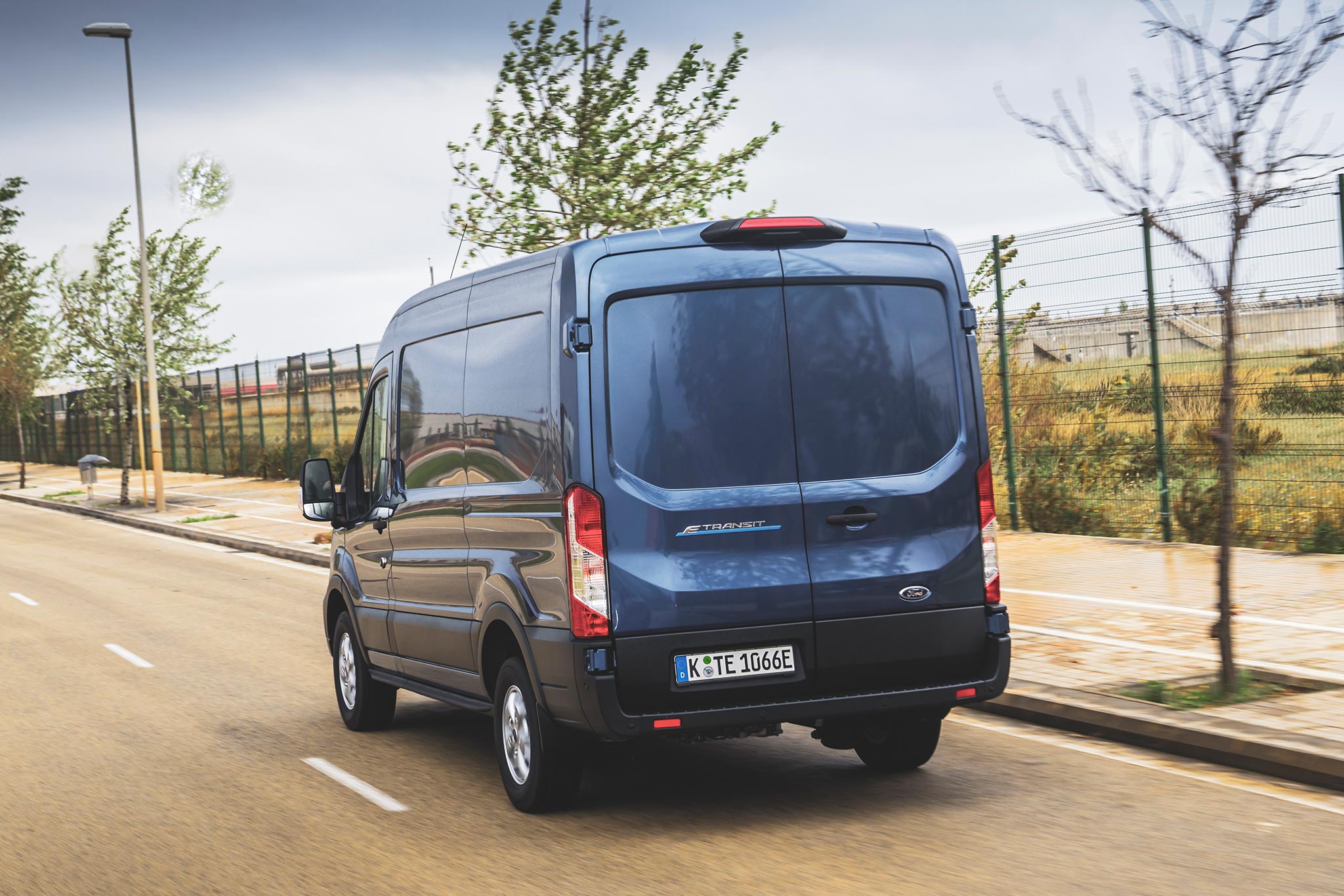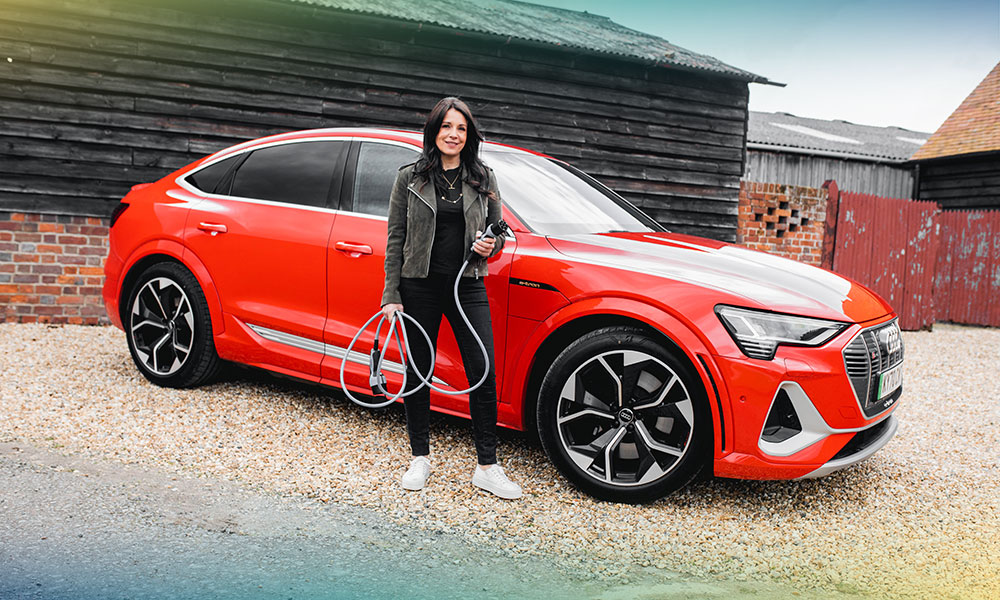Introduction
There are a lot of reasons why electric power does make so much sense for commercial vans. It makes them quiet, powerful and easy to drive. They’re allowed into low-emissions zones in cities for nothing (though they still need to be registered), and they cost less to run and service. As long as they’ve got enough range, they’re a bit of a no-brainer.
The good news is that the Ford E-Transit is also no poorer than its forebears in terms of working practicality. You can have the new E-Transit in three lengths and two heights, including a bare chassis for sticking specialist equipment onto, a double-cab set up for up to seven people, and various other configurations.
There are bits of blue on the grille that mark it out as electric, but you’re not going to be overwhelmed by space-age Transitness. In fact, it's easy to miss that it's electric other than when you notice the charge port on the nose. If it ain’t broke, and all that... In the most regular panel van, you can have sliding doors both sides, and rear doors that open properly wide to reveal between 9.5 and 15 cubic metres of loadspace (depending on the wheelbase and roof height in question), and it’s all very well-equipped with tie-downs and helpful hooks and lips.
The battery - like an electric car - is mounted out of the way under the floor, and the heavy duty rear suspension has been redesigned to cope with proper loads and still make the E-Transit handle properly whether loaded or unloaded. Again, it depends on the version, but it’ll take up to 1,758kg of … things.
More? There’s also the option of a thing called ‘Pro Power Onboard’ which is usually known as a vehicle-to-load system. Basically a set of plugs in the back that can provide up to 2.3kW of power (that's the same that you get out of a normal plug socket in your house) for anything from a laptop to a drill. Handy if you’re on site all day.
But when all’s said and done, it needs to work for the driver/user, as well, and that’s where the E-Transit really scores. This isn’t like the old, smelly diesel Transits we know and love; it’s more like a decent car these days. There’s a 12-inch touchscreen from the Mustang Mach-E that gets Ford’s Sync 4 system, so there’s over-the-air updates for the sat-nav, voice control, wireless smartphone integration, as well as a load of driver aids like lane-keep assist and cruise control. Then there are standard heated seats and a Quickclear heated windscreen, parking sensors and keyless start. And, of course, Apple CarPlay and Android Auto.
With storage absolutely everywhere, comfortable - if practical - seating and a simple rotary gear selector in the centre console that frees up space in the footwell, it’s a lovely thing. And the simplicity of the spinny gear selector is handy if you’re doing lots of manoeuvring.
But more than that, this doesn’t feel like a Transit van. It doesn’t rattle, smell of diesel and somebody else’s lunch, for a start. It’s smooth, it’s quiet (for a van, especially) and it’s dead easy to drive. Just pick the gear and go.
There are two versions; one with 181bhp and 317lb ft of torque, and another one with 265bhp and the same torque figure. The 181bhp version is plenty; it keeps up with traffic thanks to fuss-free acceleration and un-vanlike smoothness. Not sporty, but it makes the E-transit weirdly serene, in a very good way.
Generally, though, the E-Transit is a revelation. It’s cheaper than rivals, has more range and is super to drive. With the big ‘Ford Pro’ support package from the manufacturer on offer as well, it’s probably a more significant vehicle for Ford than something like the Mach-E. And that’s saying something.
Battery, range and charging
Ford consulted with delivery companies to see what an acceptable level of range would be for end users, and they said ‘more than 150-miles a day’ - so the E-Transit should have every eventuality covered with a max-possible 196 miles according to WLTP figures, especially if the van spends most of its time in town, where it can be most efficient.
There are huge caveats with that, though. As with any electric vehicle, the range will drop in cold weather or if you're on the motorway, but once you also factor in the possibility of a van full of bricks, the driving style of your average Transit driver (think Grand Prix / stunt professional), and the inevitable aerodynamic challenges of a van, then you can see real-world range plummet very easily. We wouldn't be surprised if the E-Transit actually managed more like 100 miles in real world use, if it's lugging big loads on the motorway all the time. But there are a huge number of vans that spend all of their time urban-bound on delivery duties, which is where the E-Transit will really shine.
The E-Transit comes with one battery option - a 68kWh lithium-ion unit, with the motor by the rear axle (the E-Transit is rear-wheel drive), and all the control units under the nose. Cleverly, those electronics are packed in such a way as to mimic a crash structure in the event of a collision. Oh, and the spare wheel is under the nose as well, if you choose to option one.
You get 11.3 kW AC charging as standard, which will be really useful for charging at depots that can typically support this sort of charging speed, and that you can charge in just over eight hours if you are connected to commercial-spec three phase power. There's DC rapid charging of 115kW via the nose-mounted charging point - which should be good for a 15 to 80% charge in just over half an hour.
Customers also have access to the FordPass charging network, which really helps when you’re out and about. This means that the van is logged into an account, and automatically starts to charge when you plug the van into a rapid charger that's compatible with the FordPass network. It'll then send the VAT receipt directly to the office, too. Nifty.
Practicality and load space
Ok, so this is where it gets a bit complicated when it comes to ‘spec’ on an E-Transit, because there’s quite a few ways to skin this Ford cat. With three possible lengths and two height options, as well as a bare chassis cab (to which any specialist equipment can be bolted), there’s a few options. Add to the mix crew-cab choices to carry people and a couple of different trims, and there’s a fractal of possibles.
But suffice to say, there’s about as much practicality on offer as any vehicle on the market, and even the fully-independent rear suspension doesn’t interfere. There’s a plethora of tie-downs and Pro Power Onboard as an option, which can deliver 2.3kW of 240v power direct from the traction battery for powering tools on-site. That means operating a bandsaw for a couple of miles of range per hour - handy if you’re at a place where you can’t plug in, and means you don’t need to carry a petrol generator.
Interior, design/styling and technology
The obvious stuff is that the E-Transit gets a crisp, clear 12-inch touchscreen from the Mach-E and a load of possible driver assistance systems. There’s back-up and top-down cameras for parking, and if you’ve got a fleet of more than five Transits, there’s Ford telematics so that you can spy… uh… check in on your gang, monitor the vehicle’s health and do all sorts of other stuff, so you never waste time.
Then there’s the Ford Pass Pro app for your phone so that you can do loads of stuff remotely, and access to aggregated charging. Forgotten to lock the van? You can do it from home. And yes, there’s remote start and pre-conditioning, too, so a Transit is ready to go when you are.
On the safety front, with its collision-avoidance systems and plenty of airbags, the E-Transit looks like it’ll do well should the worst happen, and there’s obviously been some thought put into the whole thing; the control electronics in the nose have been bolted together in such a way as to mimic a crash structure if you have a front-on smack. No news as to whether any of the systems will stop a driver putting door dings into other parked cars on the way to grab the fourth Ginster’s pasty of the day, though.
Motors, performance and handling
With no load on board, the 181bhp of the ‘standard’ Ford E-Transit is perfectly acceptable, but even loaded up, the way that electric power makes torque really suits a van. With independent rear suspension, it's secure empty or loaded up, but generally the E-Transit swooshes around with much more verve than a 2.0-litre diesel. It’s not fast, but it doesn’t need to be; what it is, is confident and smooth. There’s a 265bhp version (the same torque), but we haven’t tried that yet. Stick that motor into the smallest Ford E-Transit and it might be quite the thing.
There are driving modes just like an electric car, too. Normal is for everyday Transiting, ‘Slippery’ is for when it’s wet and awful out - handy if you’ve got a big load in the back - and Eco helps you get the most from the battery by limiting acceleration, top speed and knocking back the climate control, and Ford reckons that could get you as much as 10% extra range. Handy if you need to just get back to the depot for a recharge.
Then there’s L Mode which increases the brake regen' when you tap the brakes once, or press the little button in the middle of the gear selector. It works, though it’s not as strong as it could be. It’s also got a really handy turning circle, and good vision - all supremely useful when piloting a big van in a city environment.
Pricing and running costs
For the latest monthly offers on this or any other van, with free fast delivery, call our partner Vanaways on 0800 368 3286
With most comparable full-size e-vans weighing in at prices that start with a ‘6’, the Ford E-Transit’s low-50s pricetag (before VAT) looks pretty good. And although rivals are catching up, the official WLTP range that the Transit manages is still close to the top of the class. Obviously, absolute costs depend on the specification, but there’s some wriggle room in the fact that the Ford E-Transit is cheap(er) in the first place. Remember there are government grants on offer for electric vans, too, as well as some huge tax advantages for the business running them.
The interesting thing about the Transit is that Ford really has thought about the whole ecosystem that surrounds running vans for business. Recognising that a big switch to electric is quite daunting, the Ford Pro ecosystem will help with purchasing, financing, setting up the infrastructure for multiple-vehicle charging, monitoring/telematics, servicing - literally everything. If you’re a fleet manager with loads of vehicles, that’s invaluable.
Verdict
The fact remains that there are loads of advantages to electric vans, even without all the Ford support. While the government grants for electric cars have been stopped, commercial electric grants are still relatively generous. Plus, electric vans are predicted to be up to 40% cheaper to service than the equivalent diesel, and far cheaper to charge up than to refuel - especially if powered by a low-cost renewable tariff back at a depot rather than a public charger.
Ford seems confident; there’s a 3yr/60,000 mile warranty on the van, and an 8yr, 100,000 mile warranty on the battery. Interestingly, there’s also a neat loophole in government regulations. On a standard UK driving licence, you can only drive vehicles up to 3.5tonnes, but the biggest Transit is officially 4.25, so should be ineligible. BUT, because the e-Transit is considered ‘alternatively fuelled’ you can drive the big Transit on a standard licence. Handy.





























